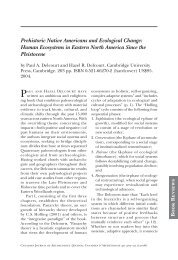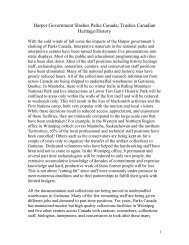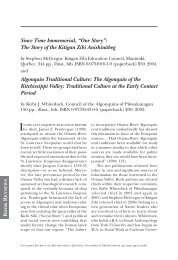(1): numéro de l'atelier / session number Abel, Tim - Canadian ...
(1): numéro de l'atelier / session number Abel, Tim - Canadian ...
(1): numéro de l'atelier / session number Abel, Tim - Canadian ...
- No tags were found...
Create successful ePaper yourself
Turn your PDF publications into a flip-book with our unique Google optimized e-Paper software.
Denton, David and John Bosum (Cree Regional Authority) People, Place andCustom: Exploring and Passing on Historical and Archaeological Knowledge in theRupert Diversion Area (18) Between 2006 and 2010, the Archaeology and CulturalHeritage Program (ACHP) worked on the land with el<strong>de</strong>rs and community members fromthe Cree communities of Waskaganish, Nemaska and Mistissini on a community-basedprogram to explore, document and commemorate the lands affected by the RupertDiversion. The paper first examines the historical significance of places, the knowledgerelated to them and the people who lived there. We discuss the sometimes complexinterplay between archaeological work and interpretations, and Cree historical knowledge.The paper then presents current work to pass on the project results through educationalproducts, and discusses issues of how to best represent the past, respecting both Creeknowledge and perspectives and archaeological findings. This work is fun<strong>de</strong>d byNiskamoon Corporation and the Société d'énergie <strong>de</strong> la Baie James, with additionalsupport from Ministère <strong>de</strong> la Culture, <strong>de</strong>s Communications et <strong>de</strong> la Condition féminine. -Des gens, <strong>de</strong>s lieux et <strong>de</strong>s coutumes : Découverte et transmission <strong>de</strong> l'héritage historiqueet archéologique dans le secteur <strong>de</strong> dérivation <strong>de</strong> la rivière Rupert. Entre 2006 et 2010,les archéologues du programme sur l'archéologie et la patrimoine culturel (ACHP), <strong>de</strong>concert avec les aînés et les membres <strong>de</strong>s communautés <strong>de</strong> Waskaganish, <strong>de</strong> Nemaska et<strong>de</strong> Mistissini, ont travaillé sur un programme visant à explorer, documenter etcommémorer le territoire touché par la dérivation <strong>de</strong> la rivière Rupert. D'abord, cettecommunication explore l'importance historique <strong>de</strong> certains lieux sur le territoire, lesconnaissances reliées à ces lieux et les personnes qui y ont vécu. Nous examinonsl'interaction parfois complexe entre les interprétations archéologiques et les connaissanceshistoriques cries. Nous présentons ensuite les démarches en cours pour diffuser lesrésultats <strong>de</strong> nos recherches par le biais <strong>de</strong> produits éducatifs et comment mieuxreprésenter le passé, en respectant à la fois la perspective historique crie et les découvertesarchéologiques. Ce travail est financé par la Société Niskamoon et la Société d'énergie <strong>de</strong>la Baie James, avec le soutien du Ministère <strong>de</strong> la Culture, <strong>de</strong>s Communications et <strong>de</strong> laCondition féminine.Desrosiers, Pierre (Avataq Cultural Institute) Lithic Raw Material and the Size ofPalaeoeskimo Territory (7) Exotic lithic materials are remarkably frequent finds inPalaeoeskimo assemblages. By documenting the “chaîne opératoire” of tool production, itis possible to explain why and how some raw materials have travelled across such longdistances from their source to final <strong>de</strong>stination. This paper will discuss the differentmo<strong>de</strong>ls that consi<strong>de</strong>r size of territory, exchange networks and/or direct procurementstrategies. The notion of territory during the Palaeoeskimo period will be explored, usingexamples drawn from lithic quarry sites, production at resi<strong>de</strong>ntial sites, and ethnographicdata.Diaz 1 , Alejandra, M.P. Richards 1 , Suzanne Villeneuve 2 , Brian Hay<strong>de</strong>n 2 1 Departmentof Anthropology, University of British Columbia, Vancouver, BC, Canada 2 Departmentof Archaeology, Simon Fraser University, Burnaby, BC, Canada Stable Isotope Analysisin the Mid-Fraser Region: Determining Prehistoric Diet in British Columbia (11) Thispaper explores dietary adaptations of humans using stable isotope analysis as a means ofdirect dietary reconstruction. We discuss results of carbon, nitrogen, and sulphur dietaryisotope analyses of canid and human remains from the Mid-Fraser region of British








